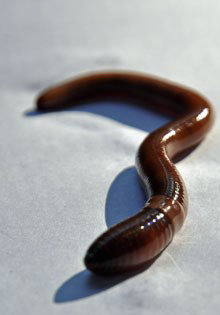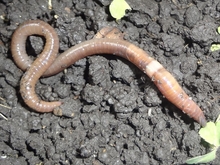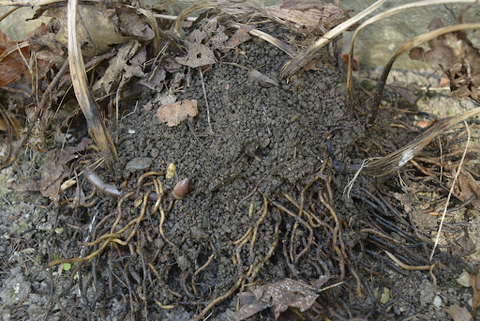Quick facts
Jumping worms will be a prohibited invasive species in Minnesota on July 1, 2024. Prohibited invasive species are unlawful (a misdemeanor) to possess, import, purchase, transport, or introduce except under a permit for disposal, control, research or education. The DNR will not require people who unintentionally have jumping worms on their property to get a permit from the DNR.
If your garden club does plant sales, follow our plant sale guidance to prevent the spread of jumping worms.
- As their name implies, they jump, wiggle and are very active.
- Jumping worms live in the leaf litter and the top few inches of soil on the forest floor.
- They change the soil texture to appear like coffee grounds, strip the soil of nutrients and can kill plants.
- Prevention is the only known way to manage them.
- Jumping worms should be disposed of in the garbage. Do not release them into the environment.
Jumping worms should be reported. Learn how to report invasive species in Minnesota.
Why be concerned about jumping worms?
Jumping worms (Amynthas spp.) are an invasive species native to eastern Asia. In fact, no earthworms are native to Minnesota.
Jumping worms contribute to major forest ecosystem disturbance and are also troublesome for homeowners and gardeners. They negatively impact soil structure and reduce plant growth.
Earthworms, including jumping worms, are ecosystem engineers. By changing soil characteristics, they contribute to a number of other ecosystem shifts that may ultimately increase allergies and Lyme disease, reduce crop and forest productivity, and reduce forest biodiversity.
Like all earthworms, there are no research-based management options, so preventing their introduction and reducing their spread are the only two proven forms of management.
Jumping worm identification
- Jumping worms can be 1-1/2 to 8 inches or more in length.
- They are similar in size to other earthworms such as nightcrawlers or some of the larger angle worms, but their clitellum (collar-like ring) and coloring are different.
- The clitellum is located 1/3 the length down the worm from the head, and it is smooth, cloudy-white and constricted, unlike the swelled saddle-like clitellum of European earthworms.
- These worms may jump and wiggle noticeably when disturbed. They can move across the ground in an “S” pattern like a snake.
- Jumping worms live for only one season.
- They hatch in late spring in 1-4 inches of soil.
- The worms grow during the summer and the adults start laying eggs in August.
- We don't know how many eggs each adult can lay.
- Eggs are very small but can be identified. Removing eggs is likely impractical. The University of Wisconsin–Madison has more on jumping worm egg identification.
Jumping worms in Minnesota
- In Minnesota, jumping worms have been found in home and landscape gardens.
- They are surface and shallow-soil dwellers and have a large potential range within the state.
- A current map of confirmed jumping worms in Minnesota can be found on the EDDMapS invasive species mapping system.
Starting July 1, 2024, the Minnesota Department of Natural Resources (DNR) will regulate jumping worms as prohibited invasive species making it unlawful (a misdemeanor) to possess, import, purchase, transport, or introduce jumping worms except under a permit for disposal, control, research, or education. To learn more about the regulation details visit the DNR’s website.
The DNR’s Frequently Asked Questions has great information for home gardeners with jumping worms, anglers worried about jumping worms and people interested in vermiculture.
Jumping worms should be reported. In your report include close-up photos of individual worms with a clear view of the location of the clitellum (collar-like ring around the body). You can also include photos of the soil if it looks like coffee grounds.
Make your report using one of the following methods:
- Report using the EDDMapS web-based mapping system for documenting invasive species.
- Report to the Minnesota Department of Natural Resources: Laura.Vanriper@state.mn.us or 651-259-5090.
Once you submit a report do not call the DNR, University or Extension to confirm it arrived. The agencies and researchers working on jumping worms will get the report and will follow up if necessary.
Jumping worm community science volunteers explored jumping worm management options. Review the final results summary to see what worked and didn't and review the list of plants and how they responded to jumping worms.
Managing your emotions
Are you sad you have jumping worms? Worried you're the only one? You're not alone, learn more about the emotions jumping worms create and ways to process these feelings in this short resource for people with jumping worms.
Management
There are no pesticides labeled for worms in the United States. No products can legally be used in Minnesota as pesticides, including for jumping worms, if they are not labeled and regulated by the EPA and the Minnesota Department of Agriculture. Prevention is the only known management for worms.
Prevention
Everyone can play a part in preventing the spread of earthworms, including jumping worms.
Don’t buy worms advertised as jumping worms, “snake worms”, “Alabama jumpers” or “crazy worms” for any purpose.
Anglers: Dispose of unwanted bait worms in the trash. Never release any worm into the environment — all earthworms are non-native in Minnesota.
Gardeners: Be on the lookout for jumping worms in soil, potted landscape plants, mulch or compost. If you see soil that looks like coffee grounds or notice unusually jumpy worms in your mulch:
Don’t move any material that might be harboring jumping worms.
Report any suspected jumping worms.
Composters: If you purchase worms for composting, know how to identify the species you are buying.
Check your order to make sure it doesn’t have jumping worms in it.
When out enjoying nature, follow the recommendations of PlayCleanGo: Stop Invasive Species in Your Tracks:
REMOVE plants, animals, and mud from boots, gear, pets and vehicles.
CLEAN your gear before entering and leaving a recreation site.
STAY on designated roads and trails.
Surveillance
There are some easy ways to watch out for worms, including jumping worms, in your landscape. For more information visit the Great Lakes Worm Watch.
Disposal
Jumping worms, as with all worms, should be disposed of in the garbage. Do not release them into the environment.
Download Coping with jumping worms (PDF) for a quick reference on how a Master Gardener approaches control with integrated pest management techniques.
Is there something I can use to kill the worms?
- There are no proven, researched-based tools for controlling jumping worms. There are no pesticides approved for worm control in yards and gardens. Researchers are looking into options, but there are no recommended control measures at this time beyond hand removal and disposal in the trash.
- It is not known how various soil amendments impact jumping worms. There is no known combination of gardening activities that reduce jumping worms.
- Here is what we know about various treatment ideas:
- “Early Bird” fertilizer: This is a fertilizer, not a pesticide. It is not labeled as a pesticide for earthworms, despite claims that it may control them. Currently, there is no evidence that this product is effective at reducing jumping worms; research is ongoing. It is illegal to use fertilizer as a pesticide.
- Tea seed pellets: This is fertilizer and should not be used as a pesticide. Tea seed pellets are not registered for use or sale in Minnesota, making them illegal to use.
- Biochar: There is very limited research on biochar and its impact on earthworms generally. We're unaware of any research related to jumping worms and biochar specifically. The research on earthworms generally and biochar found there is a limited short-term negative impact on earthworms and no long-term negative impact on earthworms when using biochar.
- Insecticides: Earthworms are not insects, they are annelids. Insecticides must be used according to the label instructions for the target species on the label.
Can I send my leaves and plant matter to the local yard waste site?
Call your local yard waste site and ask if they follow the “process for further reducing pathogens” in their composting method. This process makes sure that compost reaches high temperatures (131°F or above) and involves turning compost piles on a schedule. If the facility is following that process they will likely be able to kill jumping worms and their eggs. Following this process also kills weed seeds.
Should I still add mulch, compost or wood chips to the soil? or does that just feed the jumping worms?
Research on jumping worms is limited. We know that jumping worms are great at digesting cellulose, a key component of wood chips. This allows them to survive and spread in mulch.
It is unclear if adding mulch, compost or wood chips to the landscape improves the environment for jumping worms. It is clear these activities do not limit jumping worms. More research is needed to establish recommendations for best landscape practices when jumping worms are present.
My garden club puts on a plant sale. How can we prevent the spread of jumping worms?
If a site is known to have jumping worms, the safest thing to do is to not move plants and soil off the site. Jumping worm cocoons (egg cases) can be hard to see and might be in the soil even if you don’t see any adult worms.
As a general best practice for plant sales to reduce the risk of spreading worms and weed seeds, wash the soil off plant roots with water and then re-pot in clean potting soil, or sell as bare-root plants.
See Plant sale recommendations to reduce jumping worm spread in the drawer below.
Does it help to harvest worms?
Harvesting and throwing worms into the trash should reduce the number of worms and prevent those worms from reproducing. It is unclear what level of worm harvest will produce a meaningful difference in your landscape.
Are there any strategies to limit jumping worm spread in a geographic area?
Anything to reduce the movement of materials that may harbor jumping worms or their eggs even within your yard will reduce the speed at which a jumping worm infestation spreads.
- Limit the movement of soil, mulch, compost and plants from one location to another.
- When moving and replanting, clean soil off plants and remove any visible worms.
- Washing plant roots in water may also help prevent the spread of worms.
How do I find suppliers for worm-free mulch, sod, wood chips, fill or outdoor-grown plants?
Contact potential suppliers and ask if they are aware of jumping worms, what steps they take to prevent jumping worms from getting in their materials, and if they inspect their products for jumping worms.
Suppliers can prevent the introduction of jumping worms to their facilities by using clean equipment and inspecting new materials brought into their site. They can check their products and site for jumping worms before selling materials.
There is not a list of worm-free suppliers.
How do I get compost that does not have jumping worms?
If you are purchasing compost, you can ask if the supplier follows the “process for further reducing pathogens” in their composting method. This process makes sure that compost reaches high temperatures (131°F or above) and involves turning compost piles on a schedule. If the facility is following that process they will likely be able to kill jumping worms and their eggs. Following this process also kills weed seeds.
When do eggs hatch? Is there a time of year when cocoons (egg cases) won’t be in the soil?
If jumping worms are present at a site, then jumping worm cocoons can be present in the soil year-round. Many eggs will begin to hatch in the spring when soil temperature regularly goes above 50°F (10°C), but not all eggs will hatch at once. Some will hatch later in the year and some will remain unhatched throughout the summer and over the next winter. This is a life-history strategy in many worms and insects to ensure that some eggs will still be viable if droughts, heatwaves, or other conditions unfavorable for worms that do hatch, occur in a given summer.
What temperatures kill jumping worms and their eggs?
A study showed that jumping worms die when held at 85°F (29°C) for three days. The study also found that jumping worm eggs die when held at 104°F (40°C) for three days. Juvenile and adult worms can move around, so the worms may move to places where the temperature is lower if that is an option. Exact temperatures that can kill worms and their eggs can vary depending on soil moisture or other factors. The study did not look at shorter periods of heat exposure.
Is it normal to feel sad, fearful, panicked, impatient and angry after learning I have jumping worms?
Yes, jumping worms and their impacts cause all of these emotions in landowners. You are not alone. Check out this 2022 report about the emotional impacts on volunteers who are working to manage jumping worms in their landscapes. Learn more about how to manage the emotional toll of jumping worms.
Plant sale organizers and participants can play a big role in limiting the spread of invasive jumping worms. Soil, plant roots and mulch are the most likely materials to spread jumping worms during plant sales.
Prevention
- If a yard or garden is known to have jumping worms it’s safest to not accept plants or garden materials from that location.
- Look at a current map of confirmed jumping worms in Minnesota.
- Spread the word to plant salegoers about jumping worms, their identification and proper reporting.
Early detection
If you think or know you have jumping worms do not provide plants and materials to a plant sale even if you plan to take measures to remove worms. Soil that looks like coffee grounds is an indicator of jumping worm presence.
Worried about jumping worms in your garden? Check out the Great Lakes Worm Watch website for information on how to sample for and identify worms.
Rapid response and reporting
If you think you have jumping worms, report them with high-quality photos for verification. Photos need to be in focus and include the ring (clitellum) around their body showing its distance from the head.
Preferred reporting methods are:
- Use the EDDMapS free mobile app. Download from the EDDMapS website
- Laura Van Riper, MN DNR
Management: Plant sale best practices
- Accept only plants from gardeners that have looked for jumping worms and use these practices to prevent their spread:
- Plants and materials do not come from an area known to have jumping worms.
- There is no reason, like soil that looks like coffee grounds, to suspect there are jumping worms at the site that produced these plants or materials.
- Remove soil from all plants before transporting them to limit the spread of weeds and worms. This helps to remove earthworm cocoons (egg cases) or weed seeds.
- Completely submerge plant roots in water and wash away remaining soil. Actively look for worms. Protect clean roots for transportation and sale.
- Water is sufficient to remove soil and other materials from the roots.
- Sell bare-root plants when possible.
- If plants must be sold in soil, repot with clean potting soil.
- The best way to ensure clean soil is to buy bagged and weed and disease-free potting soil from a reputable dealer.
- Do not use mulch, leaves, backyard compost or other material that may harbor jumping worm eggs or weed seeds.
- Gather and transport plants ready for sale on surfaces like concrete, tarps or trays where the newly potted plants cannot pick-up contaminated materials like soil, leaves or mulch.
You can download a printable version of this information for your next plant sale.
University of Minnesota Extension has led the way in creating new or improved common names for many different jumping worms invasive to North America. Learn more about the various jumping worm common names and the work to improve troublesome invasive species common names in Minnesota.
Earthworms - Minnesota Department of Natural Resources
Final Results Summary: 2020 - 2022 Jumping worms: Report management
Jumping worm - Minnesota Department of Natural Resources
Research Update: Jumping Worms and Sleeping Cocoons - University of Wisconsin-Madison Arboretum
Gupta, A., Rager, A., Weber, M., Dombeck, E., & Pelaez Mosquera, S. (2018) By Land and By Sea: Identification Guide to Non-Native Species for Minnesota. Field Guide, Book. University of Minnesota.
Reviewed in 2024




